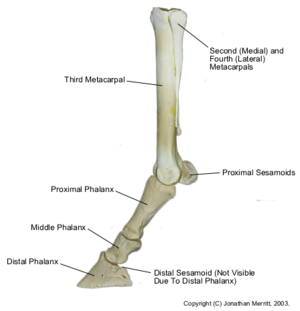This article needs additional citations for verification. (April 2008) |
| Pastern | |
|---|---|
 The bones and joints of the equine forelimb distal to the wrist (or carpus): The fetlock (metacarpophalangeal joint) is located between the cannon bone (third metacarpal) and the long pastern bone (proximal phalanx). The pastern joint (proximal interphalangeal joint) is located between the long pastern bone and the short pastern bone (middle phalanx). The coffin joint (distal interphalangeal joint) is located between the short pastern bone and the coffin bone (distal phalanx). | |
 Shock absorption of the pastern joint | |
| Details | |
| Identifiers | |
| Latin | Pāstōrius |
| Anatomical terminology | |
The pastern is a part of the leg of a horse between the fetlock and the top of the hoof. It incorporates the long pastern bone (proximal phalanx) and the short pastern bone (middle phalanx), which are held together by two sets of paired ligaments to form the pastern joint (proximal interphalangeal joint).[1][2] Anatomically homologous to the two largest bones found in the human finger, the pastern was famously mis-defined by Samuel Johnson in his dictionary as "the knee of a horse". When a lady asked Johnson how this had happened, he gave the much-quoted reply: "Ignorance, madam, pure ignorance."[3]
- ^ Hadden, WA; Rogers, C; Wilcox, GJ, eds. (2005). "Chapter 3: Pastern". Horseman's veterinary encyclopedia (Revised ed.). Guilford, Connecticut: The Lyons Press. pp. 87–100. ISBN 978-1-59228-527-3 – via Google Books.
- ^ Thomas, HS (2005). "Chapter 7: Foreleg conformation". The horse conformation handbook (1st ed.). North Adams, Massachusetts: Storey Publishing. pp. 105–40. ISBN 978-1-58017-558-6 – via Google Books.
- ^ James Boswell. "Chapter 14". The Life of Samuel Johnson LL.D. Archived from the original on August 10, 2008.